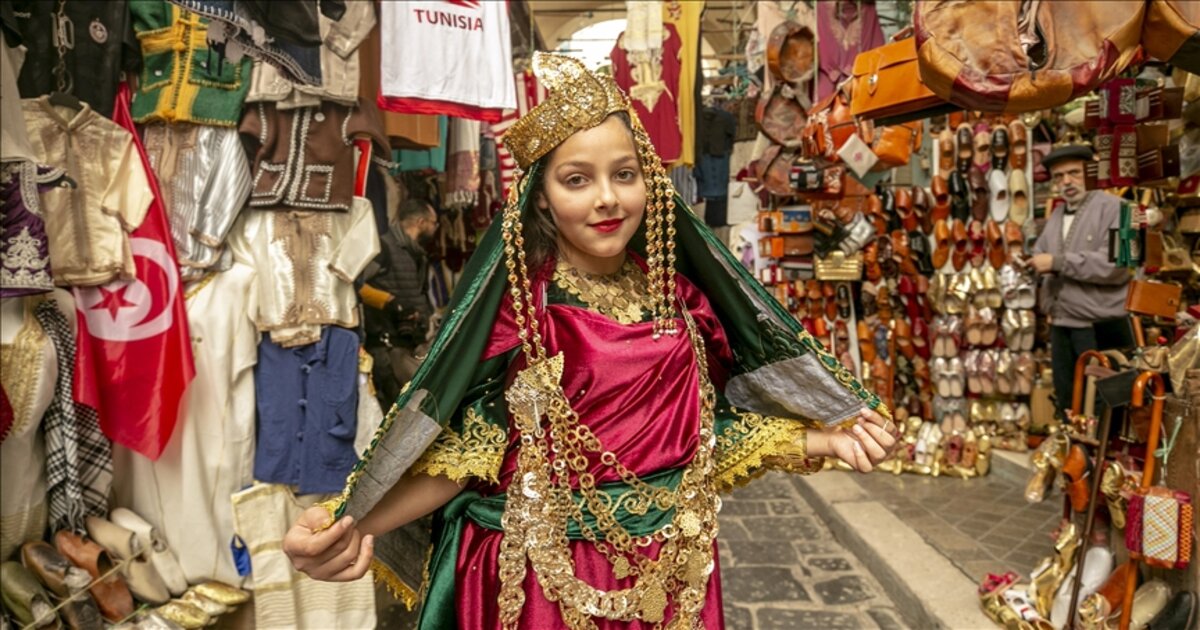In the history of Tunisian traditional dress, it is essential to recognize the deep influence of the diverse civilizations that have passed through Tunisia. Each of these civilizations has left a distinctive cultural imprint, contributing to the rich variety of traditional garments found across the country's regions and governorates. These cultural treasures include a remarkable array of attire, each reflecting the unique identity and heritage of its region. Join us as we explore the traditional outfits featured in this first episode.
The Kessoua
The Tunisian Kessoua is the most sought-after wedding attire in Tunis, known for its prestige. Consisting of two pieces, it includes a top called the bustier or "Blouza," richly adorned with embroidery, pearls, and crystals. The bottom, also known as "fouta," is a wide, long skirt that matches the Blouza. The Kessoua subtly reveals the abdomen, giving it a sensual yet elegant appearance.
The Outia
The Outia is named after a special ceremony, the Henna party, during which the bride wears four different outfits throughout the evening. Luxurious and refined, it can come in several colors and is often made from precious fabrics and luxurious embroidery.
The Jeloua Djerbienne or Djerbian Wedding Dress
The Jeloua Djerbienne, also known as the Djerbian Wedding Dress, is an emblematic traditional outfit from the island of Djerba, Tunisia. This dress is specially made for weddings and is characterized by its elegance and richness of detail. It is often adorned with complex embroidery, pearls, gold threads, and traditional motifs, reflecting the craftsmanship and culture of the region. The Jeloua Djerbienne is an important piece in wedding celebrations and a symbol of Djerba's cultural identity and heritage.
The Tabdila
The tabdila, like the keswa, consists of a two-piece set: the Blouza, a richly decorated bustier, and the bottom, usually a sarouel or a wide skirt layered over fabric.
The Haïk
The Haïk is a striped piece of fabric, white or brightly colored, that wraps around the back like a small coat. It is secured with a scarf tied around the head, with the ends trailing behind.
The Sefseri
The Sefseri is a large piece of fabric covering the entire body of a woman. It is usually cream-colored and made of cotton, satin, or silk. Depending on the region in Tunisia, it can also be very colorful, especially in the south of the country. This garment is worn by women for modesty and to avoid male gaze.
The Blouza
The Blouza, often in silk and a vibrant red, is a blouse that reaches the hips, followed by fitted pants down to the ankles. It is a symbol of luxury with its gold, silver, or multicolored embroidery, true works of art.
The Tunisian Jebba
The Tunisian Jebba, an emblematic piece of traditional costume, is widely worn throughout the country. It is often worn by Tunisian men during religious celebrations, weddings, or circumcisions. Made from various fabrics such as linen (Kamraya), wool (Souf), Ftoul, white silk (Harir), or even green (Karmasoud), the Jebba comes in several styles. Its embroidery, reminiscent of Andalusian style, requires artisanal skill, with artisans proficient in hand weaving using specific tools and various types of needles..
The Burnous: A Traditional Cloak from the South
The Burnous is a sleeveless hooded cloak made of wool, traditionally worn by Berber, Amazigh men in Africa at the beginning of the 19th century. From 1831, women also began to adopt this garment, initially made from camel hair fabric with a gathered hood adorned with fringes or tassels. Today, the Burnous greatly inspires fashion designers and is often made from cashmere, taffeta, or wool, used as an ornament for evening or wedding dresses.
Merioul Fadhila: The Sweater of Our Grandmothers
The story goes that a Tunisian Jewish craftsman lovingly made a cotton sweater for his beloved before World War II. This woman was none other than Fadhila Khetmi, a theater, dance, and singing enthusiast, daughter of Nesriye Frawlou, a renowned Turkish singer and dancer who performed in Tunis's "Kafichantas" (singing cafes). Fadhila was the first Tunisian woman to create a theater troupe in 1928.
The Dengri: From Work Uniform to Trendy Fashion
The Dengri is certainly the outfit that has traversed eras and generations. Originally a work blue worn by Maoist workers, the Dengri arrived in Tunisia over half a century ago. This blue cotton jacket is characterized by its Claudine collar and Chinese buttons, often matched with pants of the same color. Once intended as a uniform for sailors and workers, the Dengri has now become a style symbol, giving a trendy look to many Tunisians. This is once again due to the creativity of stylists who have personalized the jackets with vibrant patterns and colors, proudly worn by both men and women.









